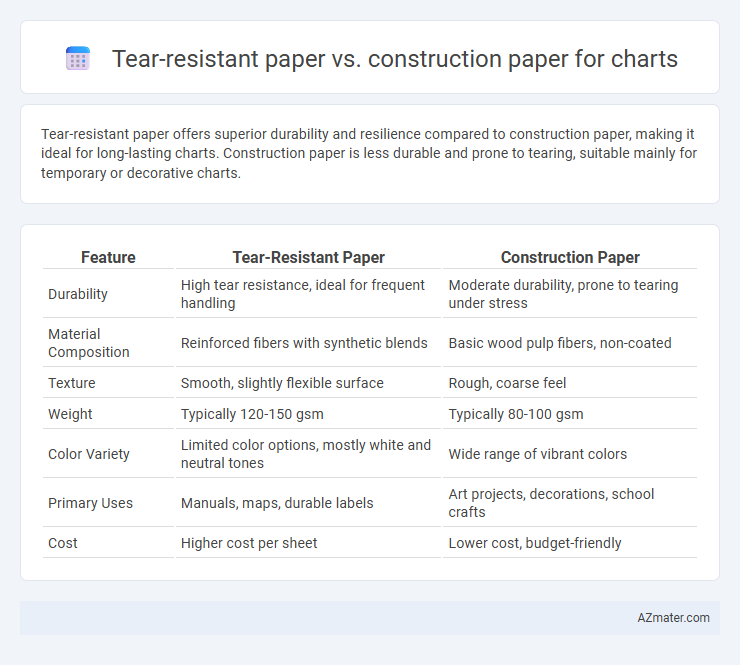Tear-resistant paper offers superior durability and resilience compared to construction paper, making it ideal for long-lasting charts. Construction paper is less durable and prone to tearing, suitable mainly for temporary or decorative charts.
Table of Comparison
| Feature | Tear-Resistant Paper | Construction Paper |
|---|---|---|
| Durability | High tear resistance, ideal for frequent handling | Moderate durability, prone to tearing under stress |
| Material Composition | Reinforced fibers with synthetic blends | Basic wood pulp fibers, non-coated |
| Texture | Smooth, slightly flexible surface | Rough, coarse feel |
| Weight | Typically 120-150 gsm | Typically 80-100 gsm |
| Color Variety | Limited color options, mostly white and neutral tones | Wide range of vibrant colors |
| Primary Uses | Manuals, maps, durable labels | Art projects, decorations, school crafts |
| Cost | Higher cost per sheet | Lower cost, budget-friendly |
Introduction: Comparing Tear-Resistant Paper and Construction Paper for Charts
Tear-resistant paper offers enhanced durability and longevity, making it ideal for charts that require frequent handling or outdoor use. Construction paper, while vibrant and affordable, is more prone to ripping and fading, which can compromise the clarity and lifespan of charts. Selecting tear-resistant paper ensures charts maintain their structural integrity and visual appeal over time.
Material Composition of Tear-Resistant Paper vs Construction Paper
Tear-resistant paper is primarily made from high-strength fibers such as cotton or synthetic blends that enhance durability and flexibility, minimizing tear susceptibility under stress. Construction paper typically consists of ground wood pulp combined with fillers and dyes, resulting in a coarse texture and lower resistance to tearing. The difference in fiber quality and composition directly impacts their performance in applications requiring rigidity and longevity, with tear-resistant paper offering superior resilience compared to conventional construction paper.
Durability and Tear Resistance: Which Paper Lasts Longer?
Tear-resistant paper offers superior durability compared to construction paper due to its reinforced fibers and water-resistant coating, making it ideal for long-lasting charts exposed to frequent handling or environmental stress. Construction paper, while affordable and vibrant, tends to tear easily and degrade faster when subjected to moisture or heavy use. For charts requiring extended lifespan and resilience, tear-resistant paper provides a significantly longer-lasting solution.
Color Brightness and Fade Resistance in Chart Applications
Tear-resistant paper offers superior fade resistance and maintains color brightness longer than construction paper, making it ideal for durable, high-visibility charts. Construction paper tends to have vibrant initial colors but fades quickly when exposed to light or handling. For applications requiring long-lasting, bright visuals, tear-resistant paper delivers enhanced performance and longevity.
Writing and Printing Compatibility: Marker and Ink Performance
Tear-resistant paper offers superior durability and maintains structural integrity when using markers and ink, preventing smudging and bleeding for clearer, sharper writing and printing. Construction paper, while vibrant and affordable, tends to absorb ink more readily, leading to increased bleed-through and less defined marker lines. For chart-making requiring legible and professional results, tear-resistant paper provides enhanced compatibility with both marker and ink applications.
Ease of Cutting, Folding, and Shaping for Charts
Tear-resistant paper provides superior durability, allowing for precise cutting and clean edges essential for detailed charts, while construction paper is thicker and can be more challenging to cut accurately. Construction paper's rigidity makes folding more difficult, often resulting in bulky creases that hinder smooth shaping, whereas tear-resistant paper maintains flexibility for sharp folds and complex shapes. For chart-making, tear-resistant paper offers better adaptability in manipulation without compromising the integrity of the paper structure.
Environmental Impact and Sustainability Considerations
Tear-resistant paper is typically made with synthetic fibers or reinforced polymers, which can hinder biodegradability and complicate recycling processes, leading to higher environmental impact compared to traditional materials. Construction paper is primarily composed of recycled wood pulp and natural fibers, making it more biodegradable and easier to recycle, thus offering a more sustainable option for charts and other projects. Choosing construction paper supports reduced waste in landfills and lower carbon emissions during production, whereas tear-resistant paper prioritizes durability often at the expense of eco-friendliness.
Cost and Availability of Tear-Resistant vs Construction Paper
Tear-resistant paper typically costs more than construction paper due to its enhanced durability and specialized materials, making it suitable for projects requiring longevity. Construction paper is widely available in most craft stores and online retailers at a lower price point, appealing to budget-conscious users and educational settings. For large-scale or frequent use, construction paper offers better availability and affordability, while tear-resistant paper provides value in applications demanding strength and resilience.
Ideal Use Cases for Educational and Professional Charts
Tear-resistant paper is ideal for educational charts requiring durability and frequent handling, such as classroom displays and project presentations, due to its enhanced strength and longevity. Construction paper, while more affordable and colorful, suits temporary charts or crafts with minimal wear, perfect for young students' creative projects but less durable for professional uses. Choosing tear-resistant paper ensures charts maintain integrity in high-traffic environments, whereas construction paper fits short-term or decorative applications.
Final Recommendation: Choosing the Best Paper for Your Chart Needs
Tear-resistant paper offers superior durability and longevity, making it ideal for charts that require frequent handling or must withstand rough conditions. Construction paper, while more affordable and available in vibrant colors, tends to be less durable and prone to tearing, which may not be suitable for long-term or heavily used chart displays. For professional or high-traffic environments, tear-resistant paper is the best choice, ensuring your charts remain intact and visually effective over time.

Infographic: Tear-resistant paper vs Construction paper for Chart
 azmater.com
azmater.com